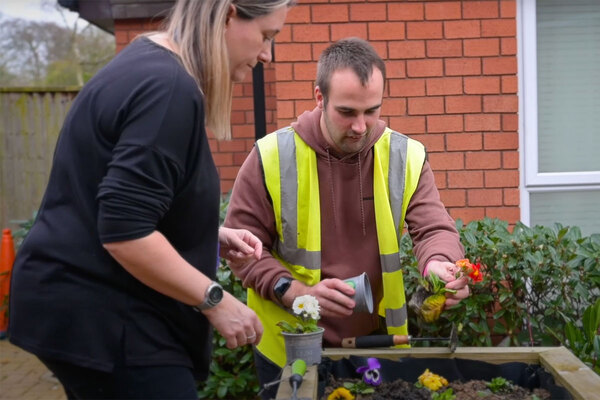You are viewing 1 of your 1 free articles
Disabled tenants have been given hope, but our new prime minister has to deliver
The prospect of new legislation to improve the accessibility of new homes for disabled people has raised hopes. Councils appear to be on board but it’s essential that Boris Johnson is too, writes Sheron Carter
A needle in a haystack. A polar bear in a snowstorm. An accessible property in the UK.
Most people looking for somewhere to live prioritise things like location, size and affordability, but for disabled people the accessibility of a potential home is paramount.
As a housing association with almost half a century of experience in the field, we know only too well how hard it can be to find an accessible home from the rate of demand for Habinteg properties.
Of course, the vast majority of homes in use today were built way before any proper consideration was given to accessibility or adaptability.
With the English Housing Survey telling us that just 7% of existing homes offer even the most basic accessibility features, it’s easy to see why the 13.9 million disabled people in the UK are at a disadvantage.
Habinteg’s insight report, Forecast for Accessible Homes, published last month, sought to investigate the extent to which local authorities are addressing the accessible homes deficit through their planning policies. The findings revealed a worrying forecast.
We estimate that by 2030 just 23% of homes outside London will be built to an accessible or adaptable standard, with just 1% due to be designed with the needs of wheelchair users in mind.
A postcode lottery was also evident, with the number of new accessible homes planned in each region varying wildly from one for every 24 people in Greater London, to one for every 270 people in the West Midlands.
More concerning still is the fact that no homes in that region are planned to meet wheelchair dwelling standards. Given that we are ageing as a national population, it is hard to believe that the variation in the actual housing needs of each region are quite so pronounced.
For me, it’s clear that it doesn’t have to be this way.
A new national policy making the accessible, adaptable standard (M4 Category 2 in the technical jargon) the mandatory baseline for all new homes is what we need – and it’s what Habinteg tenants told equalities minister Penny Mordaunt when they met with her to discuss our report findings last month.
“I have high hopes for the consultation announced by Theresa May last month, which is looking at changing the law so that all new homes are accessible and adaptable by default”
Category 2 homes provide access features such as a level entrance and an entrance-level WC but also offer some critical future-proofing features that allow easy adaptation to accommodate the changing needs of occupants.
In a Category 2 home, common adaptations like the fitting of a bathroom grab rail or stairlift are quick and easy to do.
Rest assured that as a property type, it doesn’t look much different from its less adaptable cousins. Call it an ordinary home with hidden adaptive superpowers.
So I have high hopes for the consultation announced by Theresa May last month, which is looking at changing the law so that all new homes are accessible and adaptable by default. As well as providing people with a greater number of homes that can adapt and change over its lifetime, such policy offers developers the certainty and consistency of expectation across the country, levelling the playing field and setting an expectation for quality, inclusive homes wherever they’re being built.
Such policy can also dovetail with other key goals high on the sector and global agenda. Accessible and adaptable homes can be every bit as energy efficient as their less accessible counterparts. They can also be provided in any tenure and they can be built off site if that is the local preference.
“Accessible and adaptable homes can be every bit as energy efficient as their less accessible counterparts”
More attractive still is the fact that building accessibly and adaptably from the outset will save on both financial and environmental impact later down the line because adaptations and modifications are both faster and easier to make.
What would we get from making this change? We’d have a higher proportion of accessible and adaptable homes, which will enable people to maintain their independence, reduce unnecessary health and social care costs, and improve the health and well-being of individuals and families.
Planning teams would also be able to focus more on getting their policies on wheelchair standard dwellings into a shape to meet local needs. As a direct result of our insight report, it has been encouraging to see some local authorities getting in touch with us and our training and consultancy department, Centre for Accessible Environments, looking for support developing and implementing their accessible homes policies.
While very pleased with the prospect of the consultation, it’s important to remember that the UK’s new prime minister, Boris Johnson, won’t be obliged to fulfil the plans that Ms May set out.
So it was also good last month to see that after housing secretary James Brokenshire committed to looking at the evidence presented in Habinteg’s report, the Ministry of Housing, Communities and Local Government released the long-awaited planning guidance about how councils should plan for accessible homes.
We hope this prompts those local authorities that haven’t yet done so to update their plans with more robust requirements to meet the accessible housing needs of their whole community.
In doing so, this alone may at least reduce the size of the national haystack facing home hunters of the future.
Sheron Carter, chief executive, Habinteg












